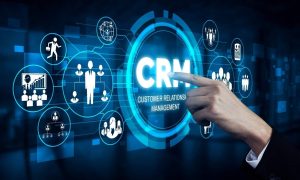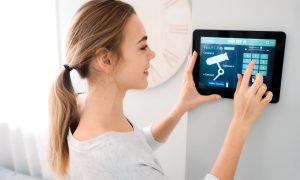The security landscape for apartment complexes has changed dramatically in recent years. Property managers are tired of dealing with lost keys and middle-of-the-night lockouts. Residents want better security without sacrificing convenience in their daily lives. Smart access control systems offer solutions to these common problems.
These security innovations have transformed how people enter and exit their buildings. They fix security gaps that traditional lock-and-key systems couldn’t address. The technology keeps getting better, with new features rolling out regularly. Let’s look at why these systems matter for modern apartment living.
What Is Smart Access Control?
Smart access control uses electronic systems to manage entry points without physical keys. People use digital credentials instead – key fobs, cards, mobile apps, or PIN codes. The “smart” part comes from connectivity and advanced programming options.
These systems connect to networks and can be managed from anywhere. They track who enters and exits, creating useful security records. Property staff can change permissions instantly without replacing any hardware. The technology works through RFID, Bluetooth, WiFi, or cellular connections.
Most modern systems run on cloud platforms that offer incredible flexibility. They work with cameras and intercom systems to provide complete security coverage. Some even connect to other smart home features for a fully connected living experience.
Advantages of Smart Access Control for Apartment Complexes

Smart access brings benefits beyond just ditching physical keys. These systems transform security across entire properties. They fix problems that have frustrated building managers for decades. The technology works well for properties of all sizes and types.
Small apartment buildings get enterprise-level security without enterprise-level costs. Large complexes benefit from easier management across hundreds of doors. The return on investment usually becomes clear within the first year after installation.
Enhancing Security with Time-Sensitive Access Codes
Time-sensitive access codes are game-changers for property security. These temporary credentials work only during specific time windows. When the scheduled period ends, the code stops working automatically, preventing unauthorized access once legitimate business ends.
Maintenance workers get codes that work only during their scheduled repair times. Delivery people receive access only during expected drop-off windows. Property tours can be self-guided with codes that expire after the showing. Every entry gets logged for perfect accountability.
Building managers can also restrict amenity access during certain hours. For example, the pool or gym can lock automatically after posted closing times, eliminating the need for staff to monitor these areas constantly.
Streamlining Visitor Management
Smart access transforms how apartment buildings handle visitors and guests. No more messy sign-in sheets with scribbled names. Residents create temporary codes for visitors through simple mobile apps. The process takes seconds and doesn’t require front desk help.
Delivery drivers no longer need to call multiple units when delivering packages. They get one-time codes for package rooms or lobbies only. Food delivery works the same way, making the process smoother for everyone. Every visitor interaction becomes both more efficient and more secure.
These improvements help properties without full-time desk staff the most. Residents get doorman-level security without the cost of 24/7 staffing. The technology essentially provides constant concierge service through smart automation.
How Keyless Entry Benefits Property Managers

Property management teams face unique challenges in balancing security and operations. SmartAccess addresses these challenges directly with impressive results. The technology improves daily operations across entire properties.
Improved Operational Efficiency
Keyless entry dramatically cuts the time staff spends on key-related tasks. No more making duplicate keys or rushing to help locked-out residents, and no more replacement costs when residents lose their keys. These savings add up quickly, especially in larger buildings.
Unit turnovers happen faster without key management headaches. Maintenance teams get immediate unit access without collecting physical keys. Leasing agents show apartments without returning to the office between tours, saving time and allowing staff to focus on more important work.
With less time spent on keys, staff can address resident needs more effectively. They provide better service without increasing headcount. The technology essentially improves service quality while reducing administrative burdens.
Centralized Control
Property managers gain full oversight through centralized access dashboards. They manage permissions across multiple buildings from one screen. Changes take effect instantly with a few clicks throughout the property. This control creates powerful advantages over traditional systems.
Managers can immediately revoke access for problem residents or those breaking the rules. They can grant emergency access to first responders during crises. The system allows for detailed permission settings based on resident status. All these functions can be done remotely from anywhere with internet access.
This approach works exceptionally well for companies managing multiple properties. Regional managers keep an eye on their entire portfolio from any location. They implement consistent security practices across different properties easily. This standardization improves overall security management.
Enhanced Security Audits
Smart access systems create detailed records of all entry and exit activity. These digital logs show who accessed what areas and exactly when. This information helps when investigating security incidents. It creates accountability that traditional locks simply cannot provide.
Managers can review access patterns to spot unusual activity and verify staff movements throughout the property during shifts. The data helps optimize staffing based on when people actually use amenities. These insights support better decision-making beyond security.
Insurance companies increasingly recognize these audit features as risk-reducers. Some offer premium discounts for properties with comprehensive access tracking. The documentation helps defend against false claims about access issues, representing another financial benefit beyond operational savings.
How Residents Benefit from Smart Access Control
While management benefits are impressive, resident advantages drive adoption. Smart access fundamentally changes how people experience apartment living. It solves problems that traditional security never addressed properly.
Convenience Meets Peace of Mind
Residents stop worrying about lockouts or lost keys entirely. Their smartphones serve as credentials they rarely forget. Many systems offer backup access methods for complete peace of mind, eliminating a common source of stress for apartment dwellers.
Coming home with groceries no longer means struggling with keys while bags slip. Returning from a run doesn’t require fishing for keys in tight pockets. These small improvements make a real difference in daily life. Residents quickly wonder how they lived with traditional keys before.
Many systems also confirm that doors are properly locked after leaving. This addresses a common worry that bothers people after leaving home. Peace of mind alone justifies the technology for security-conscious renters.
Increased Safety for Families
Families find particular value in smart access features. Parents can verify when kids arrive home through access notifications. They can give limited codes to babysitters or after-school caregivers. The technology adds safety layers for vulnerable household members.
Children no longer carry easily lost physical keys that show where they live. They use codes or mobile credentials specific to their home only. Parents get alerts when these credentials are used at unexpected times, creating safety nets that traditional keys cannot provide.
Many parents say these features significantly reduce their daily worry. They feel confident their children remain protected even when parents aren’t home. This peace of mind proves invaluable for family-focused apartment communities.
Customizable Access for Roommates
In shared living situations, smart access allows personalized credential management. Roommates get individual access rather than sharing physical keys. This prevents one roommate’s lost key from compromising everyone’s security. It also makes roommate changes much simpler to handle.
The technology allows for quick permission updates when roommate situations change. Property managers update access without changing locks or making new keys. This flexibility proves especially valuable in properties catering to students. It addresses common problems in shared housing situations.
Some systems even show who most recently unlocked the door. This feature helps resolve disputes about who may have left doors unlocked. The transparency improves communication and reduces conflicts among roommates.
Reducing Security Risks with Smart Access Control
Beyond convenience, smart access addresses specific security vulnerabilities. These systems provide solutions to problems traditional security cannot handle, creating multiple protection layers against various threats.
Mitigating Tailgating Risks
Tailgating—when unauthorized people follow legitimate residents through doors—creates major security risks. Smart access fights this through several approaches. Some use sensors to detect multiple entries with a single credential. Others connect to cameras to verify authorized access visually.
Many systems send push notifications asking residents to confirm unexpected entries. These alerts create immediate awareness of potential security problems. Residents have become more conscious about secure entry points. This awareness significantly reduces successful tailgating attempts.
Technology extends security consciousness beyond the management office. It makes residents active participants in maintaining building security. This collaborative approach works better than traditional security methods.
Responding Quickly to Emergencies

Smart access enables faster response times during emergencies. Property managers can grant immediate access to first responders and remotely unlock areas to help evacuate during fire emergencies. These capabilities save critical minutes when time matters most.
The systems can connect with fire alarms to automatically unlock particular doors. They can temporarily restrict access to damaged areas after incidents. These automated responses prevent additional damage or risk. They function even when property staff cannot reach the location quickly.
After emergencies, access logs help reconstruct events for insurance claims. Management can review precisely when and how people evacuated. This information helps improve emergency response plans. It creates continuous improvement for property safety measures.
Conclusion
Access control systems have graduated from being upscale amenities to becoming a mandatory property foundation. They address historical security problems while delivering operational effectiveness. The system improves resident satisfaction and enhances security measures for properties. Forward-thinking property managers should prioritize implementation because of these benefits.
Property security features have become crucial factors determining which properties prospective renters choose. Smart access technology has transformed properties into outdated spaces in the eyes of tech-conscious renters. The technology has become a necessity that property managers cannot afford to disregard. Due to this situation, property owners need to choose the right time for implementation.
Due to its ongoing development process, the technology will deliver enhanced capabilities. Real estate properties that adopt flexible systems maintain substantial competitive advantages for emerging technological developments in the future. The security infrastructure becomes adaptable by implementing systems that can easily integrate new features. The approach of looking ahead ensures that rental markets achieve long-term success in their evolution.
Also Read: What’s the best property management app of 2025?
FAQs
Installation costs range from $300 to $1,000 per door, depending on hardware quality and features.
Yes, most properties can install wireless systems without extensive modifications.
Most systems include battery backups and offline modes that maintain security during outages.
They typically receive single-use codes or temporary access through resident-generated permissions.
Most systems offer multiple access methods, including simple key fobs requiring no technical knowledge.



